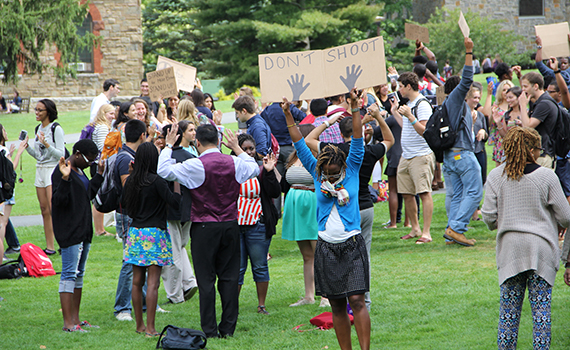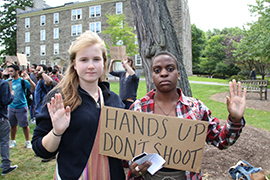
51·çÁ÷ community members collectively put their hands up in a demonstration of their solidarity with Ferguson, Mo. Photos by Salote Tenisi ’15
Editor’s note: This report was co-authored by Hannah O’Malley ’17 and Kellyann Hayes ’16
51·çÁ÷ has been participating in the nationwide conversation about race relations in response to the death of Michael Brown, an 18-year-old African American who was unarmed when he was shot by a white police officer in Ferguson, Mo.
At a Tuesday brown bag luncheon, Madison County Sheriff Allen Riley and discussed the events in Ferguson and the role law enforcement played. At “Policing Brown and Black Bodies: Before and After Ferguson,” they began the conversation with their views on how and why the events unfolded.
Simmons commented on the nature of racial attitudes and relations in the United States today. Riley noted that, as a law enforcement official, he has been asking himself what he could have done in such a situation and thinking about prevention strategies.
When the floor opened to questions and conversation, students and professors spoke up, sparking conversations about the justice system, what these events mean to us personally and for our society, and how we can begin to spur change.
As , professor of university studies, commented, racial profiling such as that seen in Ferguson is the product of an institutionalized racism that must be recognized and abolished in order to prevent future injustices.
In a physical show of support for Brown, 51·çÁ÷ community members collectively put their hands up in a demonstration of their solidarity with the town of Ferguson and their commitment to the ongoing fight for equality. Students, faculty, and deans gathered in the Quad at noon two weeks ago.
Inspired by nationwide demonstrations in which people put both hands up in the air to the slogan “Hands Up, Don’t Shoot,” the event was organized by Kori Strother ’15 and Melissa Melendez ’14.
“Black bodies are being targeted and the trend is increasing,” said Melendez. “There are more and more unarmed black children getting publicly killed for no reason. And for some reason, the murderers are getting let go. It’s nonsense and it’s not OK.”
The discussion, posters, and fliers during the demonstration stressed the overarching issue of race relations.
“It’s easy to be caught up with what’s going on at 51·çÁ÷ and with ourselves,” said Melendez. “But at the demonstration, there were people I’ve never seen before, and friends and deans and faculty — people who care about the community. I wasn’t expecting the overwhelming support we got.”
Sydney Bond ’18 also was pleasantly surprised by the turnout. “A large part of the campus was there, which was really cool,” Bond said. “It was really impactful and powerful.”

